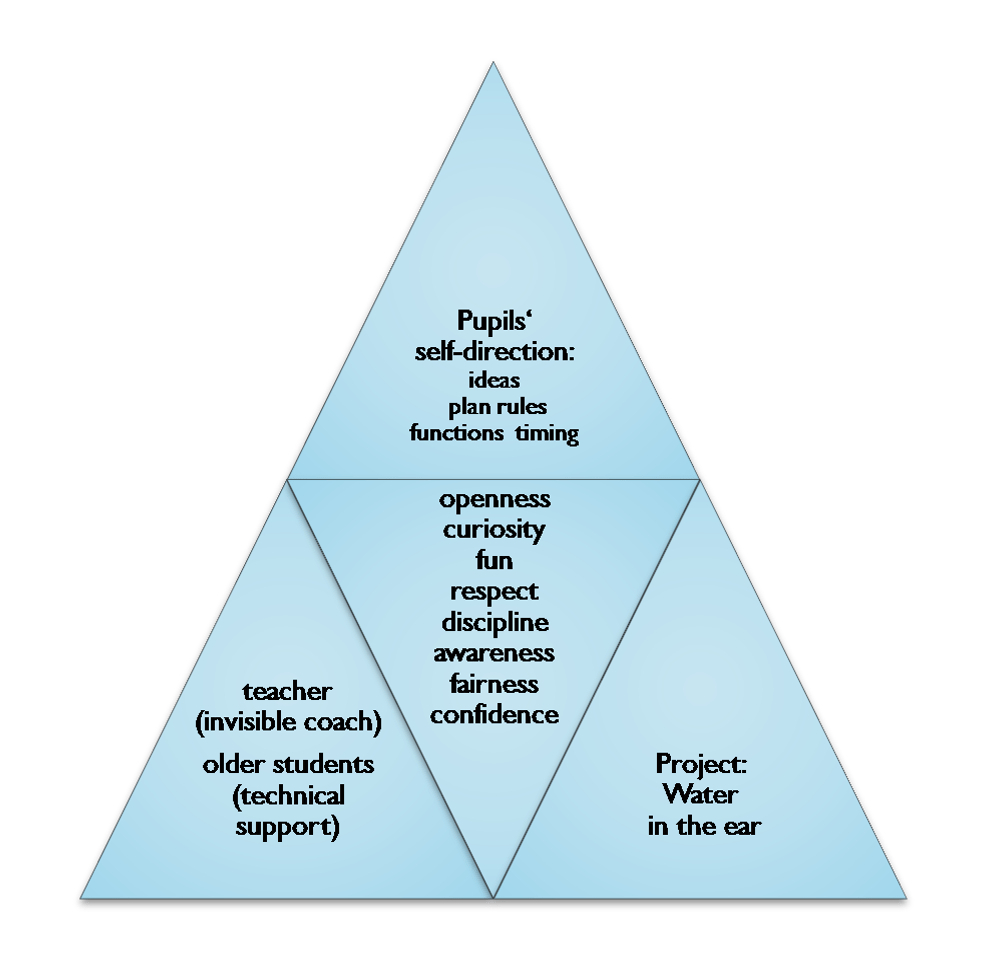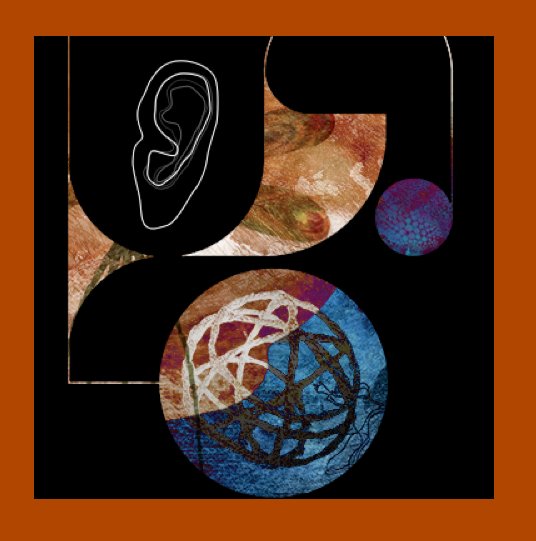In this contribution my intention is to show what learning in resonance can be in everyday work in school. I want to invite you to two projects in the following steps. In an introduction you will be informed about a project titled “Wasser im Ohr” (i.e.” Water in the ear”). The next step reflects this project under aspects of “school as a space of resonance” by Hartmut Rosa, an actual German sociologist. Then I want to describe the second project “Garten.Vogel.Klang.Welt“ (i.e.”Garden. Bird. Sound. World”). The fourth part, a reflexion, focuses on “the hidden correspondence between inner and outer nature”[1] in the context of learning in resonance. The last part as a conclusion tries to integrate the different aspects of “learning in resonance” in reference to the two projects.
1. Project “Water in the ear”
In this project pupils of class 4 of the Gemeinschaftsgrundschule Buschhausen, worked together with students of my own music class 12 (Freiherr-vom-Stein-Gymnasium, Oberhausen). The technical equipment was small: recorder, microphone, headphones, camera and later operator, sheets of paper, pencils and colours. The idea was to improve the auditive competence by collecting and describing sounds inside and outside the school under the aspect “water”. Before our first meeting I recorded some sounds and presented them to the pupils. They guessed what they were and where they were. Then they had many ideas to collect more sounds inside and outside the school. We made a list. The pupils planned an adequate way from one location to the other and we discussed upon rules in the group. The time span in the timetable then was small – one and a half hour.
To work economically we needed different functions in the group. Here they are:
– a navigator – he/ she helps us to find the next place
– a “stop and go-person” with a non-verbal signal, who organizes where the walk stops, how to hold the silence during the recording and when the walk continues
– a micro assistant, who hold the micro very near to the sounding source. In some moments a risky job, e. g. when holding the micro from a bridge at a long rope a few centimeters above the surface of the Emscher, a naturalized river nearby
– a sound technician with headphones and recorder (here MiniDiscPlayer, nowadays you would use a mobile phone)
– a photographer who documents the situation
– a “security assistant” around the group and
– a dogsbody for all the things, which happen unforeseen. In this way everybody got a job.
During the walk I myself was only a member of the group, which worked totally self-directed. We recorded sounds inside and outside the school. Meanwhile the students of my music class prepared “a little studio”, a nice room under the roof of the school, with operators, sheets of paper, pencils, colours and so on, so that we were able to work on after the walk. The pupils worked on highly motivated. A few days later they had a lot of material: recordings, a sound map, drawings, a sound riddle and ideas for work sheets. After a few units they were able to present the project to other pupils and also to their parents and teachers. The project was very well accepted by all of them. The pupils were also very proud of it. Step by step some of the elements could be integrated into the curricula of different school subjects.
2. Reflexion 1 . Hartmut Rosa “School as a space of resonance”[2]
To get another point of view, I wanted to analyze where in this project “resonance” –in Hartmut Rosa’s understanding- took an effect. Every situation, which has to do with listening, evokes resonances – physically and psychically. Sounds bring us to other locations and situations, we enjoy them, we compare the sounds with others of our biography and we classify them.
Referring to school, Hartmut Rosa. speaks about “a space of resonance”. His statement bases on ideas of Werner Jank and Hilbert Meyer concerning the so called “didactic triangle”[3]. A “didactic triangle” shows the relationship between pupils or students, teachers and educational objectives. In this triangle the process of learning evokes, that world is set in vibration“[4]. Coming back to the project “Water in the ear” it is possible to show the elements of the “resonance triangle”.

Important was the openness of working self-directedly concerning the locations, where they wanted to record, the walk, the timing and how to continue the work in the studio and in everyday school life. They also decided about rules and functions guided by respect and confidence. Then the “subject” itself focused to a phenomenon in everyday life developed another form of awareness. Further on the role of the teacher und the older students as coaches was nearly invisible, supplemented by curiosity and fairness.
3. Project “Garden. Bird. Sound. World”
In this project the disciplines biology and music in class 5 of my own school (Freiherr-vom-Stein-Gymnasium, Oberhausen) worked closely together. The curriculum in music in this period of learning had the title “The sounds around us”, the curriculum in biology “Nature and animals nearby”. These were very good conditions for the cooperation. After a long winter period we had the wish to work on something outside. The garden was our favourite place, a little island between noisy streets and great buildings.
The first day of our project we visited the garden together with our class 5. The pupils could walk around and listen to the sounds in the garden. Then we returned to our classroom with only one task: Don’t talk, take time and write down your impressions!
Later on, we talked about these first impressions. Many texts focused on the birds’ singing. In the next lessons we talked about the specific methods in music and biology and decided how we could work on. In biology we had to observe, to document, to take photos, to draw and to describe the birds. In music we had to listen, to record, to differentiate and to describe using the parameters like loudness, level, volume, speed, duration, structure and character. Then we had a wonderful learning period sometimes outside in the garden, sometimes in the classroom, often with digital support. The pupils wrote texts, created wanted posters, took photos, made drawings and maps, picked up information about the birds and compiled sounds in order to create a sound riddle. Our aim was to plan an interactive exhibition for other pupils, the teachers and the parents on “Open Day”. During this work we got a call from the ministry for climate and environment protection to take part in a project “School for the future”. We made our application with the fragments of our present work. We were elected and got an invitation to show our project publically. The motivation was high, but the final work was very hard: to finish the posters and drawings, to compile the texts, drawings and photos into a book, to optimize the PPP, the sound riddle, the lectures and so on. After this enormous effort and the publication we got a distinction by the government of Northrhine-Westfalia. All the participants were very happy and proud. We were also successful on our “Open Day”. Another highlight was also the contribution to our Summer Concert. There the pupils presented the birds’ singing as a music piece of the “famous unknown artists” between the “official” pieces for choir, orchestra and band.
4. Reflexion 2 Hartmut Rosa “From correlation to interrelation” and
“Nature as hidden teacher”
When reflecting the working process about this subject again to find “the unknown things inside the known things”[5] – it seems to be that the perspective of Hartmut Rosa’s ideas about school as a resonance space has been enlarged. In reference to the resonance triangle the working process here got more dimensions. The relations in the triangle have changed to deeper interrelations concerning resonance.
The hidden teacher was nature itself. Hartmut Rosa speaks about “a hidden correspondence between inner and outer nature”[6], in a person itself and in reference to nature. And further on his statement is “to listen and to understand inner nature by outer nature seems to be a prerequisite to a better life”[7]. He emphasizes the non-availability of nature. Things happen without human’s acting. Students and teachers are visitors for a defined span of time, in which the resonance of nature can be felt. We are allowed to participate for a while. Then after leaving the garden, nature is there for its own. Because the students’ behaviour was full of respect and consideration,they felt this specific non-availability. Hartmut Rosa describes it in the following way: “nature remains sometime stubborn and opposite” and emphasizes that human beings “perceive nature as a lively person opposite, not as something which answers all our questions”[8]. And “nature embodies a non-instrumental and non-manipulative correspondent relationship”[9].
In several levels and aspects the qualities of learning in resonance have increased. The subject itself opened more aspects referring to the two disciplines music and biology, also to linguistic and social competences. The process of work and self-direction was more differentiated, also the didactical discussion. A special challenge was the competition “School of the future” filled with moments of stress.
In the eyes of Hartmut Rosa all this relates to different axes during the project. The “horizontal axis” forms the relationship to other people, the “diagonal axis” guides the process of learning, developing competences and methods and the vertical axis introduces “in the world” itself – here the garden with the singing inhabitants[10].
Conclusion: Learning in resonance
Learning in resonance, reflected in every day work, opens the different resonance axes and their interaction. It influences the quality of communication with the world. It balances the behaviour of all participants and intensifies the power of self-effectiveness. In this way it can help to avoid processes of estrangement[11] .
Openness towards nature and arts, esteem to live generally, sensible forms of listening and awareness, care and sympathy combined with hope and resiliance can support this positive process.
Notes
[1] Rosa, Hartmut, (2020), Resonanz, Berlin, p.456
[2] Rosa, Hartmut, Resonanz , l.c., p. 402 ff
[3] Jank, Werner, Meyer, Hilbert, (2005), Didaktische Modelle; Berlin , p. 55
[4] Humboldt, Wilhelm von, Theorie der Bildung des Menschen, in Humboldt, Alexander von, Schriften zur Anthropologie und Geschichte, ed. Flitner, Theodor, Giel, Klaus, (1960) vol.1, Darmstadt, p.234 ff
In diesem Dreieck äußert sich die Vorstellung, dass „die Welt zum Klingen gebracht wird“ und in einem Vorgang, der „allein durch die Verknüpfung unsres Ichs mit der Welt zu der allgemeinsten, regesten und freien Wechselwirkung“ gelinge.
[5] Blohm, Manfred, Kolz, Burkhard, Neumann, Ines (2003), Das Unbekannte im Bekannten, in Kunst und Unterricht 270, p.4
[6] Rosa, Hartmut, l.c., p. 456 ff
[7] Rosa, Hartmut, l.c., p. 456
[8] Rosa, Hartmut, l.c., p. 457
[9] Rosa, Hartmut, l.c., p. 458
[10] Rosa, Hartmut, l.c., p. 73 ff
[11] Rosa, Hartmut, l.c., p. 299 ff



